24 October 2016
lecture series
THE SKIN OF ARCHITECTURE
The apotheosis of color: plasterwork and mural paintings in the centuries of the Baroque period
Ricardo Fernández Gracia
Chair of Navarrese Heritage and Art. University of Navarra
Color, ornament, image, magnificence and other concepts are applicable to the baroque interiors that wanted to generate an authentic caelum in terris in churches, chapels and dressing rooms throughout the 17th and 18th centuries, particularly in the latter for plasterwork and decorative and perspective painting in Navarre. As for the temporality of one system or the other, it should be noted that from the second decade of the 18th century, the large painted scenographies would make their way to triumph and replace the plasterwork from the decade of the forties of that century.
The great plasterwork ensembles
The consubstantial value and true fusion of plasterwork with architecture was assumed by promoters and mentors in such significant ensembles as the chapels of the patron saints in Pamplona and Tudela, dedicated respectively to San Fermín and Santa Ana. In the first of these cases, the academicist criticism of Don Antonio Ponz, who noted: "I am sorry to have seen in the Parroquial de San Lorenzo the monstrous ornamentation of the Chapel of S. Fermín", led to its complete shaving at the end of the 18th century. In Tudela, both the chapel of Santa Ana and that of the Holy Spirit had better luck, having been whitewashed on successive occasions, preserving all its polychromy, happily recovered in different interventions. Color, gold and plasticity are also combined in other less striking, but no less important, ensembles. In the great monasteries such as Irache or Fitero, chapels open to their temples were erected, with dedications linked to their great devotions. In Irache it was done with San Veremundo in a complex endowed with rich plasterwork in its dome, which was demolished at a late date, in 1982. Other chapels like that of San Ignacio de Pamplona, redecorated around 1730, or those located in parishes like Villafranca, Caparroso, both dedicated to the Virgin of the Rosary, San Pedro de la Rúa de Estella (San Andrés), or in convents like that of San Joaquín in the Descalzos de Pamplona, show the taste for that way of generating unreal spaces, full of rhetoric, ostentation, luxury, splendor horror vacui, celestial images and angelic hierarchies to captivate the faithful who saw them and were surprised and absorbed by their contemplation. The skill was not far from the motivations of some promoters. Thus, the Tudela Regiment agreed in 1712, at the beginning of the great citizen project of the chapel of Santa Ana and when the chapel of San Fermín de Pamplona was being completed, its intention to build the "most ostentatious chapel that can be found in the whole region".

Missing chapel of San Veremundo. Irache
The great protagonist of these ensembles, typical of the traditional Hispanic Baroque, is the ornamentation. The diverse and nuanced coloring applied on their surfaces collaborates in an authentic symphony and ornamental orgy, sensorializes even more the rich decorative program of plasterwork and stands as something attractive and surprising. All these examples, and particularly those of Tudela, are paradigms of an aesthetic that seeks to captivate through the senses, with the creation of a festive and rhetorical microcosm of true delirium.
In the middle of the rococo period we find some outstanding examples, such as the aforementioned chapel of San Joaquín, with decoration designed and carried out under the direction of Fray José de los Santos in 1750, which is completely whitewashed. In the Dominicans of the capital of Navarre, another friar, in this case of the Order of Preachers, Fray Francisco de la Vega, of the monastery of Nieva, was required to carry out the delicate vegetal plasterwork, with abundant cardinals, in 1751, for the chapel next to the sotochoir, under the organ tribune. However, the most outstanding example of the aesthetics of that last phase of the Baroque style is the sanctuary of San Gregorio Ostiense, whose chancel and chapel were redone between 1758 and 1764, with plans by the prolific discalced Carmelite Fran José de San Juan de la Cruz. The plasterwork, with great mastery of the whites and greater lightness than in previous stages, is due to Juan José Murga, being gilded by the master of Los Arcos Santiago Zuazo, from 1765.
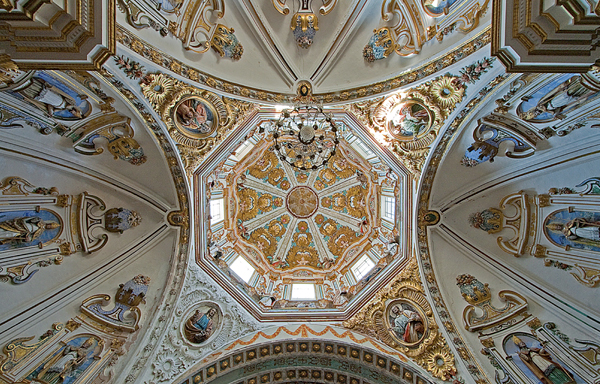
Basilica of San Gregorio Ostiense
As far as the authors are concerned, it should be noted that it was the same retablists who were responsible for their execution, again and again position . The documentation is sample clear in pointing them out. An example is what happened in the parish chapel of the then collegiate church of Tudela, dedicated to the Holy Spirit (1737-1744), where the masters José and Antonio del Río, well known for their altarpieces, became position as a whole. Likewise, the polychromy was done at position by the same masters who gilded the liturgical furnishings. In the aforementioned case, it was carried out under the direction of José Sarmiento, who used a total of 7,400 gold leafs and 3,900 silver leafs.
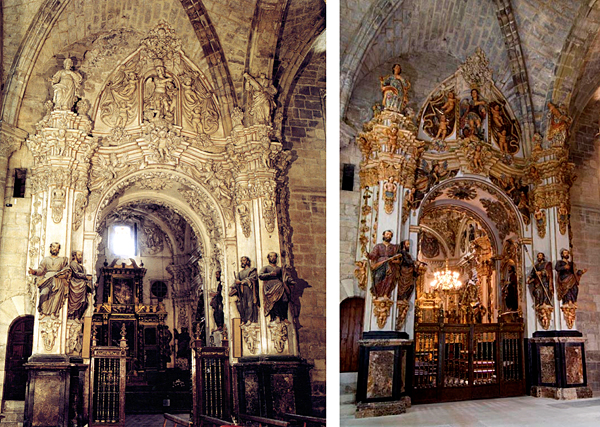
Capilla del Espíritu Santo. Cathedral of Tudela
With respect to written testimonies of how the chroniclers and preachers valued those sets, we have some. In a memorial written by the living forces of the city in 1730 to prevent the deanery from falling under the full jurisdiction of the bishop of Tarazona, we read: "The new chapel erected to our Patron Saint Anne, a true wonder that has admired our Spain and has been celebrated as a wonder by foreign nations, whose expenses, having exceeded 30,000 pesos, have the miracle of having paid for them all, and in a few years the inexhaustible treasure of the devotion of this people with their sweat and their hands. Circumstance worthy of the greatest weight for the appreciation in the scales of a dispassionate judgment". In the sermon preached by Friar Martin de Salgado on the occasion of the visit of Queen Mariana of Neoburg to Tudela, in 1739, he affirms with the exaggeration of the moment: "the primors of Art, which rushed in the Chapel Factory, the Lines of Vitrubio, the Compasses of Viñola and the proportions of Arfe. It is the Concha, that reservation, to the Lady Saint ANA...... in its construction are seen Doric and Tuscan columns, in robust Pedestals. Roses splitting the crest, in the Ionic ones; and in those of composite order, distributed, fillets, ribbons, golas, boceles and dentils. In that which is Cantería, there is no Dovela, Cimbra, incumba or cerchón, that is not the no more of the Art of the Civil Architecture. And everything that is Images, flying balconies and symmetrical fleurons, is so covered with Gold, that it is seen to stand out the Gold up to the Covering. The horizontal Floor is burnished; and so much, that it makes the feet slip, to the one who enters incautious".
Decorative painting gains ground: the seemingly infinite
Different temples in Navarre were the scene of the development of the scenographic trend. In spite of the systematic loss of this subject of works, when the paintings were eliminated in the last decades, we still have outstanding sets belonging to different typologies and moments.
The introduction was undoubtedly due to the activity of Francisco del Plano, a famous Aragonese master married to Antonia Canfranc from Tudela. Of his works, the most outstanding and at the same time the best of this genre of painting in the Comunidad Foral, is the set of painted altarpieces of the convent of the Franciscans of Viana, dating from the second decade of the century. At that time he was called "master of perspective" and "master of perspective of mutations" and years later Palomino himself would judge him to be very skilled in architecture and ornamentation "which the famous Bolognese Colonna and Mitelli assuredly did not give him an advantage". These expressions should not be surprising if we contemplate the aforementioned work of Viana, surely paid for by Don Juan de Goyeneche or by friars who left for the Indies. In all the set a true boast of the knowledge of the laws of the perspective is observed, to which a rich and exquisite ornamental repertoire is united in which architectural elements, laurels, garlands, palms, scrolls, ribbons and volutes with angelic hierarchies are mixed. skill The half-open door with the acolyte of the presbytery, as well as the balcony with the half-open lattice to which a curious one looks out, with the same procedure that the painter used in the chapel of the Pilar in the Calagurritan cathedral. The illusionism in these cases turns into real trompe l'oeil trompe l'oeil effects that try to intensify the reality so that the beholder has no shadow of doubt, that is, he does not even suspect that he is being deceived.
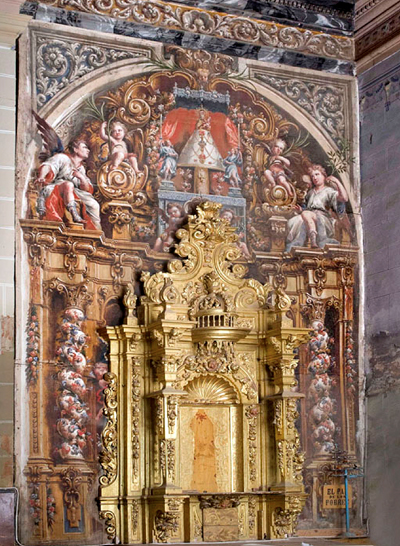
Fake altarpiece in the San Francisco de Viana convent
As for other interiors, the parish of Los Arcos, the chapels of the Sartolo in San Jorge de Tudela and of Santo Cristo in the monastery of Fitero, as well as the Shrine of Our Lady of Fair Love de la Virgen del Soto de Caparroso stand out. In the first case, at the height of the development decorativism, the parish received the most spectacular program for its richness, turning the temple into a real caelum in terris, so Pass for the baroque rhetoric. The person in charge of its realization was José Bravo, a painter from Burgos who carried it out between 1742 and 1745 and it was expensive, since it amounted to the amount of 7,868 ducats of old silver. In that project played a leading role Don Francisco Magallón y Beaumont, mayor of the town and among the words that are repeated over and over again, we find the concept "beautify" the temple with the rich iconographic program, meaning that it wanted to do something that would recreate and be pleasing to the eye and pleasing to the senses, while being proportionate and endowed with grace.
In the dome and pendentives of the chapel of the Sartolo family of the Jesuits of Tudela -today the parish of San Jorge- we find some frescoes with the glory and archangels of Aragonese filiation or perhaps of José Eleizegui, from the first decades of the XVIII century, They were made for the aforementioned chapel of the Immaculate Conception on the initiative of that family to which notable Jesuits belonged, among them the writer, orator and theologian Bernardo Sartolo (1653-1700) and the brothers Gaspar (1687-1757) and José (1680-1734) Sartolo de la Cruz, both nephews of Father Bernardo.
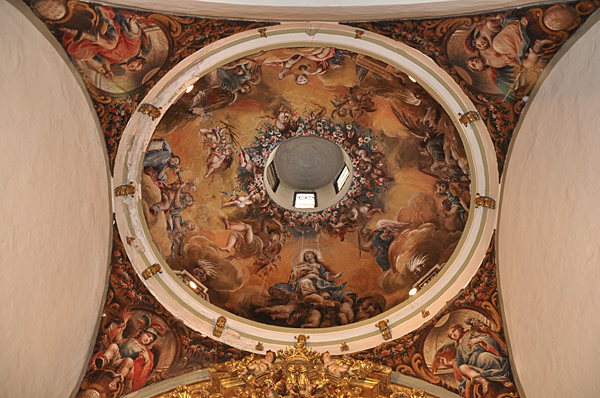
Chapel of the Sartolo. Saint George of Tudela
In the middle of the thirties, between 1732 and 1736, a large chapel with a combined floor plan was built in the monastery of Fitero to house an image of special devotion, the Christ of the guide. For its interior decoration in large frescoed walls, Aragonese frescoes of the Plano family were used, probably by Felipe del Plano.
The Shrine of Our Lady of Fair Love of Caparroso was decorated with fresco paintings made between 1775 and 1776 by the Italian Pedro Bardini and the Navarrese Andrés Mata, taking advantage of the alms of 500 pesos from Don Cristóbal Labairu. The last great set of the 18th century belongs to Luis Paret in the pendentives and cupola of the chapel of San Juan del Ramo in Viana, made between 1784 and 1787. It is a work that, due to its characteristics, escapes from the regional baroque, as it belongs to one of the great Hispanic masters of the time.
A very interesting chapter is also the decorations applied to the walls and roofs of the dressing rooms in the sanctuaries of special devotion, singularly the Marian ones. To the head of all of them the one of the Virgin of the Yoke in Arguedas, with a flat cover in which an elliptical dome is figured, work of Jose Elezegui of 1728. In the dressing rooms of the Virgen de la Esperanza, Romero de Cascante, Soto de Caparroso or San Gregorio Ostiense are still preserved good samples of what must have been very popular models in the decorations.
The other place where the scenographic paintings are located is in the back of the altarpieces. The major ones of Santa María de Viana, Miranda de Arga, Comendadoras de Puente la Reina or Iturmendi are an excellent testimony of the simulated architectures, large pavilions and the theological virtues, or angelic choirs that masters such as Andrés Mata, José Bravo, Pedro de Rada or José del Rey made.
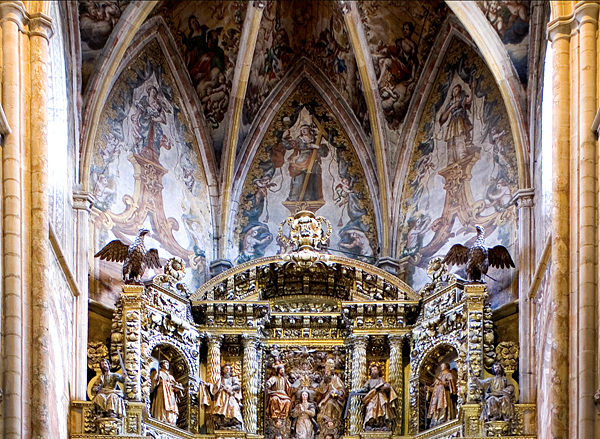
Main chapel. Santa María de Viana
